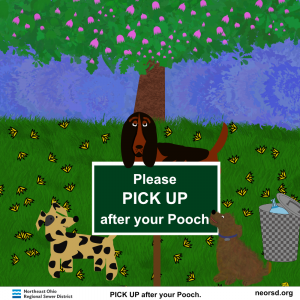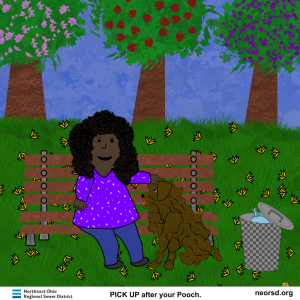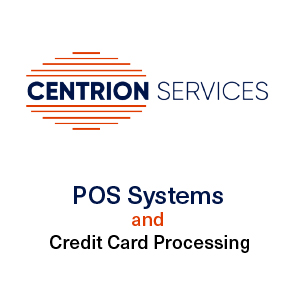Originally published in 2017 – Zealousness Issue #5
Looking for some practical ideas on how to reduce and reuse common household items? Wondering what can be recycled? Check out this article packed full of resources and tips!
What can I reduce/recycle?
Paper/Cardboard
- Most communities offer paper recycling. You can recycle cardboard, office paper, magazines, newspapers, dairy cartons, and even phonebooks! Reducing use of paper and recycling paper saves trees.
Plastic (7)
Know what the symbols mean!
#1: PET (Polyethylene terephthalate)
- Easiest and most common to recycle
- Used in soda and water bottles
- Once processed by a recycling facility, PET can become fiberfill for winter coats, sleeping bags and life jackets, bean bags, ropes, car bumpers, furniture and, of course, other plastic bottles
- PET #1 bottles should not be repurposed as reusable water bottles.
#2: HDPE (High-density polyethylene plastics)
- Used in heavier containers that hold laundry detergents, bleaches, milk, shampoo, and motor oil
- Often recycled into toys, pipes, truck bed liners, and ropes
#3: PVC (Polyvinyl chloride)
- Commonly used in plastic pipes, shower curtains, medical tubing, and vinyl dashboards.
- Once recycled, it can be ground up and reused to make vinyl flooring, window frames, or piping.
#4: LDPE (Low density polyethylene)
- Used to make thin, flexible plastics such as wrapping films, grocery bags, sandwich bags, and a variety of soft packaging materials.
#5: PP (Polypropylene)
- Some food containers and many plastic caps are made with the stronger polypropylene plastic
#6: PS (Polystyrene)
- Also called styrofoam, it is used in items such as coffee cups, disposable cutlery, meat trays, packing “peanuts” and insulation.
- Can be reprocessed into many items, including rigid insulation
#7: Others
-
- Crafted from various combinations of the plastics or from unique plastic formulations not commonly used.
- Labeled as #7 or nothing at all.
- Most difficult to recycle; most places don’t accept it, so it usually goes into trash.
- Try to not purchase #7 plastics when possible or attempt to return such items to the product manufacturers if possible
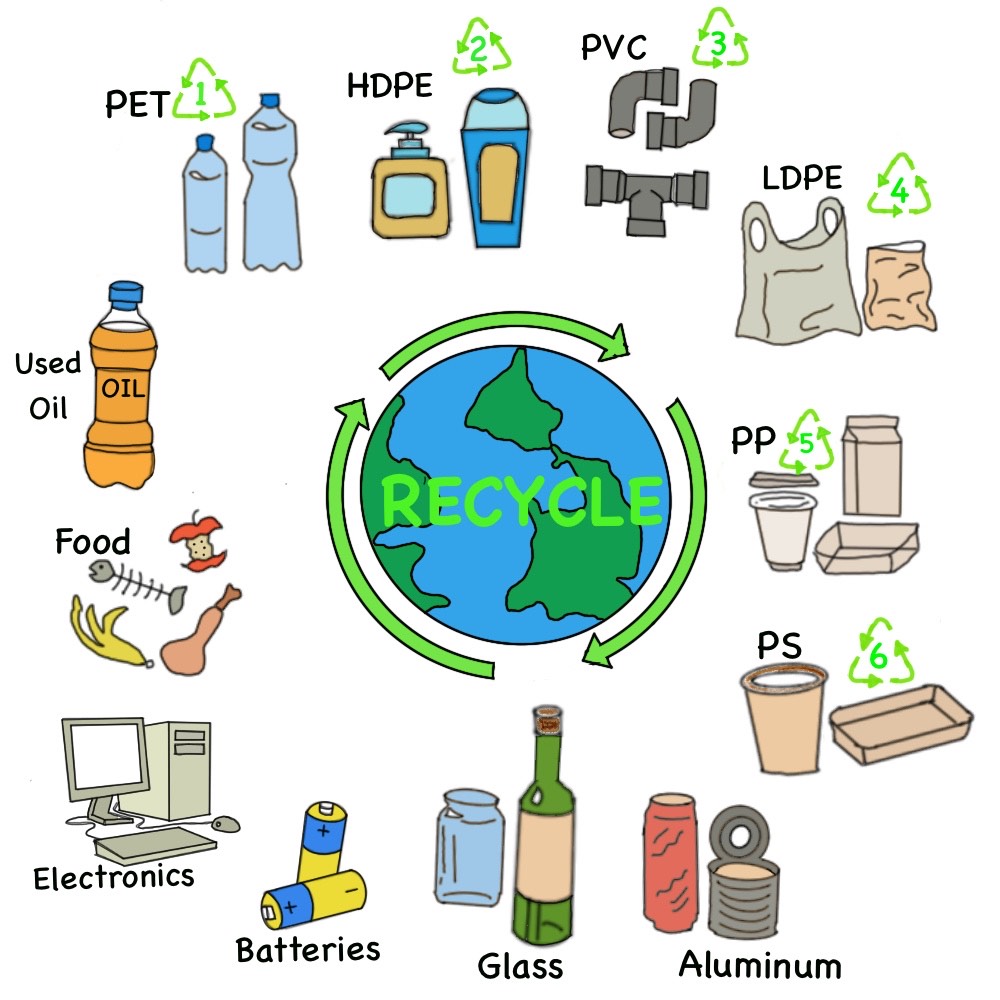
Aluminum/Tin
- Aluminum and tin cans are 100% recyclable.
- Did you know we recycle only 49% of the cans we use? (3)
Glass
- Glass can be recycled over and over again.
Batteries
- Prevention: Avoid using items that require batteries. Use rechargeable batteries when possible and recycle those when finished. Here is a list of places that take rechargeable batteries: http://ehso.com/batteries.php. Stores such as Best Buy, The Home Depot, Lowe’s, and Staples also take rechargeable batteries.
Electronics
- Your local Best Buy, Staples, or phone companies may offer drop-offs for large electrical appliances and phones.
Food
- Donate excess food or surplus inventory to pantries and food banks.
- Compost!
- Vegetables, fruits, coffee & tea grains, and garden trimmings can be composted.
- Dairy, meat, fats/oils, pet waste should not be composted.
Used Oil
- Cooking Oil:
- Some cities are taking donations of cooking oil for biofuel.
-
-
- Filter and reuse in cooking.
- Use the oil to make soap or oil lamps!
-
- Motor Oil: Many garages and auto stores also accept oil for recycling. Or look for a motor oil recycler near you: Earth911.

How else can I help?
- Borrow items when feasible.
- Maintain your items. Repair if necessary and feasible. Reuse.
- Buy items that are used, reusable, recycled, or use less packaging (2).
- Build crafts out of safe recyclable or non-recyclable items. (Check out some ideas in this article!)
- Have something you don’t want? Donate!
- Buy and use non-hazardous items.
|
Hazardous Waste Source Reduction around the Home (2) |
|
| Instead of a… | Try this… |
| Drain Cleaner | Use a plunger or plumber’s snake. |
| Glass Cleaner | Mix one tablespoon of vinegar or lemon juice in one quart of water. Spray on and use newspaper to dry. |
| Furniture Polish | Mix one teaspoon of lemon juice in one pint of mineral or vegetable oil and wipe furniture. |
| Rug Deodorizer | Liberally sprinkle carpets with baking soda. Wait at least 15 minutes and vacuum. Repeat if necessary. |
Get CRAFTY
- PLANT AND GROW: Cut 2-liter soda bottles in half and use the bottom half to grow a favorite plant or herb! The clear bottle will help you watch the plant grow. Try onions, basil, and cilantro!
- STATIONERY HOLDER: Paint empty glass/plastic jars or cans with fun colors and designs and use them to hold your pens, pencils, and other stationery items!
- FABRIC DOLLS: Use scrap pieces of fabric or reuse your old/torn clothes to build fabric dolls for yourselves or friends!
- PERSONAL COLLAGE: Use old magazines or newspapers to create a collage with pictures and words that define you and frame it in your room!
- STORAGE BOX: Decorate large cardboard boxes with paint or wallpaper to create magazine holders or a place to keep your books, games, or toys!
- DENIM IDEAS: Recycle your old jeans to make chair cushions, a new skirt, cute accessories, a tote bag, or sew pieces together to make a denim rug!
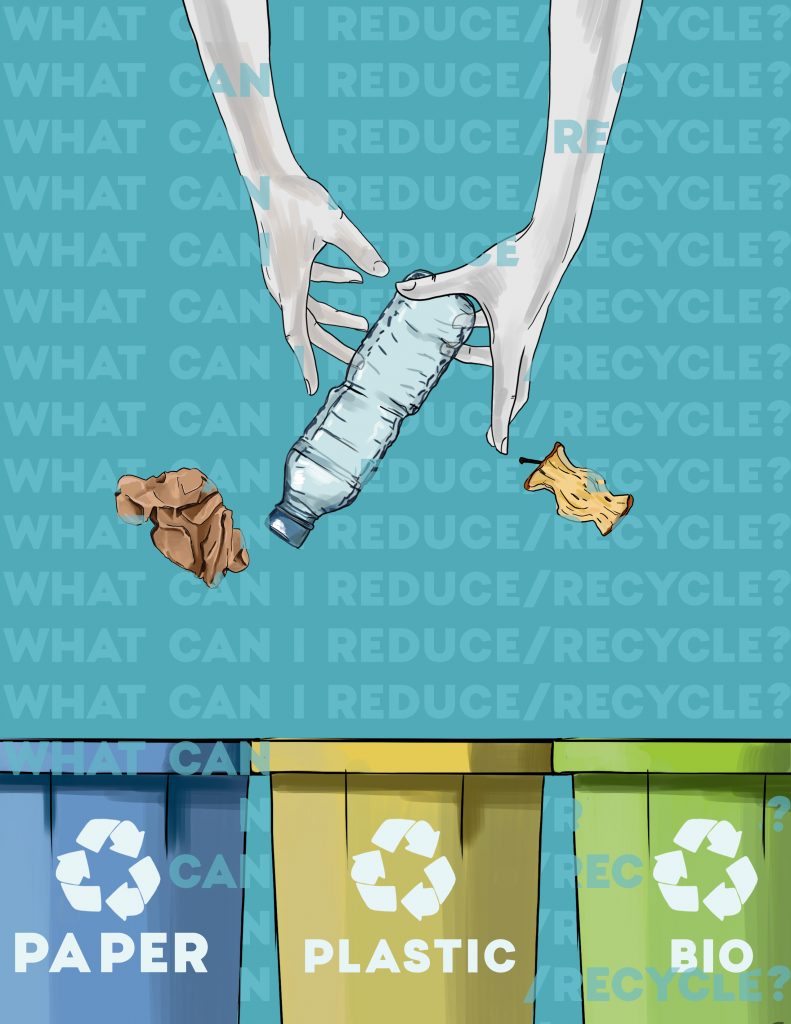
For more information, use these resources:
- EPA.gov
- neorsd.org
- Call2Recycle.org
- Search.Earth911.com
- www.WM.com
- Greener Gadgets
- RecycleNation.com
Special thanks to Northeast Ohio Regional Sewer District –
Connect with Northeast Ohio Regional Sewer District on social media
- https://twitter.com/neorsd
- https://www.facebook.com/yoursewerdistrict
- https://www.youtube.com/user/neorsdccr
- https://www.instagram.com/neorsd/
- https://www.pinterest.com/wallywaterdrop/
Make sure to check out other articles on responsible water and environmental stewardship from our blog: Water Stewardship – iN Education Inc. (ineducationonline.org)
References:
- Recyclingfacts.org. 2022. http://recyclingfacts.org/.
- US EPA,OSWER,ORCR. 2018. “Reduce, Reuse, Recycle | US EPA.” US EPA. November 16, 2018. https://www.epa.gov/recycle.
- “Waste Disposal & Recycling | Waste Management.” n.d. Www.wm.com. https://www.wm.com/.
- “Battery Disposal Guide for Households – Where to Safely Recycle Used Batteries.” n.d. Www.ehso.com. Accessed September 22, 2022. http://ehso.com/ehshome/batteries.php.
- “Cooking Oil Recycling Program.” n.d. Accessed September 22, 2022. http://www.cookingoilrecycling.org/.
- “Top 10 Ways to Recycle.” n.d. Kidzworld. Accessed September 22, 2022. http://www.kidzworld.com/article/26804-top-10-ways-to-recycle.
- “How to Recycle Different Types of Plastic.” n.d. ThoughtCo. Accessed September 22, 2022. http://environment.about.com/od/earthtalkcolumns/a/recycleplastics.htm.
- “A Healthy Environment Starts at Home. – Northeast Ohio Regional Sewer District.” n.d. Www.neorsd.org. Accessed September 22, 2022. https://www.neorsd.org/community/educational-resources/healthy-home/.






